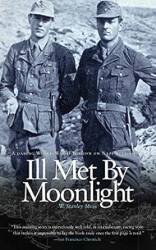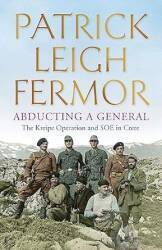
From Heraklion to the Mountain Villages
Along the Path of the Kreipe Operation with the Partisans and SOE
I was traveling west from Heraklion
to Rethymno.
On the map below you can see a mountain range along the coast
for the first half to two-thirds of that trip, with a peak
shown at 3,556 feet.
Then there's a east-west valley south of that range, with a
more major road shown with a thicker dark red line,
and a power line in black with periodic tower representations.
And then south of that, an even higher and more rugged area.
See Ανώγεια
or Anogeia, spelled on this map as
"ANÓYIA" right below the bold
84.
That's just one of today's destinations.
Ίδα
or Mount Ida is the tallest mountain on Crete,
at 2,456 meters or 8,058 feet.
The large massif including that peak is
Ψηλορείτης
or Psiloritis.
The 8,058 foot peak of Ida is visible here on this map
just below the bold green KV.
The Andartes were the partisans
who were part of the Greek national resistance during
World War II.
They were crucial players in a daring Allied mission to
capture a German general, march him to the south coast,
and load him onto a submarine bound for
British interrogation in Cairo.
This page follows the first part of their route.
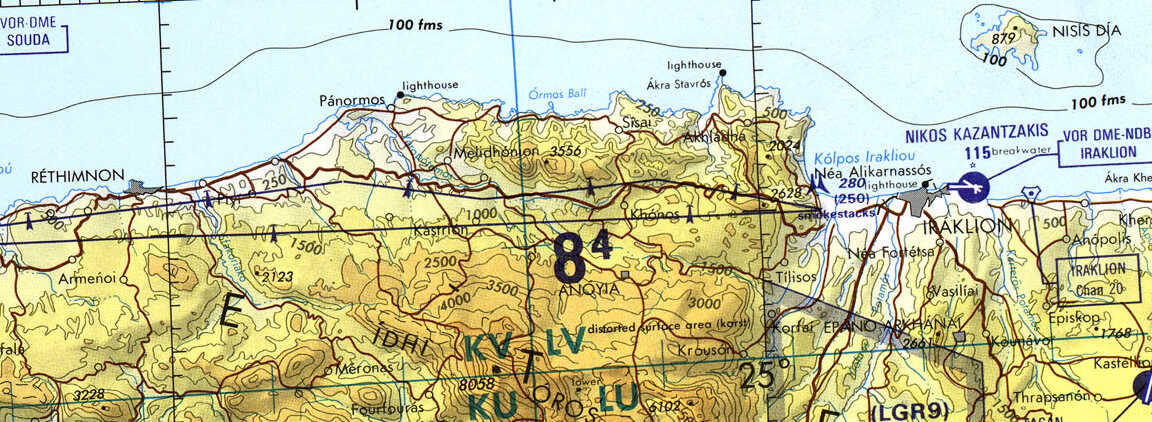
Portion of Tactical Pilotage Chart G-3D from the Perry Castañeda Library Map Collection at the University of Texas.
The abduction happened at a road intersection marked here as Archanes–Asterousia, at the southeast end of the blue path. I had been staying at the Intra Muros hostel, which just as its name says is inside the massive walls enclosing Heraklion's old city core. I was staying just a few blocks from the abduction route through Heraklion and west into the mountains. I followed their path for much of the day, out through the Chania gate and west into the mountains and to Anogeia.
The Battle of Crete
The Battle of Crete began early in the morning of 20 May 1941, with Nazi Germany launching an airborne invasion. This was the first time that Fallschirmjäger or paratroops formed the main assault, the first primarily airborne invasion in military history.
It did not go well for the Germans. The civilians with guns were shooting the paratroops as they descended. The others would wait until the paratrooper reached the ground to stab or beat them to death and then take their gun. Given the high number of casualties, and the belief that an airborne force would no longer have the advantage of surprise, Hitler prohibited most further use of large airborne operations. Allied commanders, on the other hand, were impressed by the potential of an airborne assault and began to develop the capability.
After the first day, the Allies believed that they could repel the invasion. This was also the first battle in which the Allies made significant use of ULTRA, intelligence derived from decrypting German messages, broken at Bletchley Park. That should have given the Allies a significant advantage. But the next day brought Allied communication problems, failures to fully utilize ULTRA information, successful German offensive operations, and Allied tactical mistakes. The Germans captured Maleme Airfield in western Crete and began landing reinforcements.
Allied defensive positions along the north coast began to fall, and the Allies withdrew to the south coast. Over half the Allied force was evacuated by the British Royal Navy from 28 May to 1 June, and the rest either surrendered or joined the Cretan resistance.
The first resistance movement in Crete was organized just two weeks later, in mid June 1941.
The Long Series of German Atrocities
From the initial invasion in May 1941 through their general retreat from most of Crete in late 1944, Germany assigned a series of sadistic commanders who oversaw a large number of war crimes and atrocities. The first four of the six overall German commanders over Crete committed atrocities and were convicted of war crimes after the war. Two were executed, the other two received light sentences. One of them returned to Germany to co-found a Neo-Nazi party.
One source put the total number of civilians killed by Germans on Crete at 6,593 men, 1,113 women, and 869 children. The Germans themselves officially admitted killing 3,474 civilians by firing squad, plus killing at least another 1,000 civilians in massacres in the second half of 1944.
It's hard to keep track of these psychopaths. Here's my attempt:
Luftwaffe General Kurt Student had been in command of developing the Fallschirmjäger and commanded it in the airborne invasion of Crete. He was made temporary commander of German forces in Crete after the island's surrender on 31 May 1941.
His men mistreated and murdered prisoners of war in Crete, and later in 1941 he was responsible for a wave of reprisal massacres against Cretan civilians — the Massacre of Kondomari, the Alikianos Executions, and the Razing of Kandanos, among others.
In May 1947 Student was tried on eight charges of mistreating and murdering POWs and found guilty on three. He wasn't tried for any of his crimes against the civilian population, probably because the German commanders who followed him were even worse. He was sentenced to five years of imprisonment, but was released the following year for medical reasons.
Alexander Andrae succeeded Student in June 1941 as Commander-in-Chief of "Fortress Crete". Thousands of civilians on Crete were tortured or executed under his command. In 1942 the SOE began considering a plan to capture him.
Andrae was assigned to the Reich Air Ministry in the fall of 1942, turning over command of Crete. He was captured by the British in May 1945 after the surrender of Germany, and extradited to Greece to be tried for war crimes. In 1947 he was condemned to four life sentences. But in 1951, King Paul of Greece commuted his sentence to just four years' imprisonment, and he was released in January 1952.
Andrae returned to Germany and co-founded the Deutsche Reichspartei or German Reich Party, a nationalist, far-right, and before long openly Neo-Nazi political party in West Germany. It had close ties to Savitri Devi, a French-born Greek fascist, Nazi sympathizer, and Axis spy who promoted a strange blend of Hinduism and Nazism, proclaiming Adolf Hitler to have been an avatar of the Hindu god Vishnu. Her writings continue to influence today's Neo-Nazis.
In November 1942 Luftwaffe Generalleutnant Bruno Bräuer replaced Andrae as commander on Crete. He was accused of the deaths of 3,000 civilians on Crete, systematic terrorism, deportations, wanton destruction of civilian property, and torture. He was convicted and sentenced to death on 9 December 1946, and executed by firing squad on 20 May 1947, the anniversary of the German invasion.
On 1 August 1942 Wehrmacht General Friedrich-Wilhelm Müller assumed command of Germany's 22nd Infantry Division after its involvement in the capture of Sevastopol. The division was transferred to the Aegean, where it took a major role in the Battle of Leros.
In the autumn of 1943, Müller led the German forces to victory in the Dodecanese Campaign. By this time Italy had surrendered and many of its forces had joined the Allies.
On 6 October 1943, on the island of Kos, German forces acting under his orders killed over one hundred Italian army officers, their former Axis comrades, and buried them in mass graves. His troops also committed atrocities against Greek civilians on other islands in the Dodecanese.
On 1 July 1944, after the abduction of Kreipe, Müller replaced Bräuer as the fourth German commander on Crete.
He immediately began ordering his troops to commit atrocities against the civilians. These included massacres at Viannos, Anogeia, Amari, Damasta, Skourvoula, and Malathyros, among others. He became known as "The Butcher of Crete". Along with Bräuer he was convicted and sentenced to death on 9 December 1946, and executed by firing squad on 20 May 1947.
Müller was followed as Commander of Fortress Crete by Wehrmacht Generalleutnant Ernst Klepp (18 Sep 1944 to 09 Oct 1944) and Wehrmacht Generalmajor Hans-Georg Benthack (09 Oct 1944 to 08 May 1945). By late October 1944, German forces were withdrawing across the Eastern Mediterranean. Most of Crete was free. The remaining German forces plus a few thousand strongly pro-Fascist Italians still loyal to Mussolini had withdrawn to an enclave around Chania in Crete's far northwest. And so, Klepp and Benthack didn't have much opportunity for atrocities.
As for the Italians, Mussolini had fallen from power in July 1943 and imprisoned. He was freed in a raid by German paratroopers and Waffen-SS commandos, taken to meet Hitler, and put in charge of a puppet regime in northern Italy. The Italian partisans didn't get around to killing Mussolini and his mistress until 28 April 1945, very near the end of the war in Europe.
Abducting a General
The British high command decided to capture the German general commanding the 22nd Infantry Division based in the Heraklion sector when Friedrich-Wilhelm Müller held that position. SOE officer Patrick Leigh Fermor parachuted into Crete southeast of Heraklion on 4 February 1944. Müller was replaced with Generalmajor Heinrich Kreipe on 1 March 1944. By the time the rest of the SOE abduction team, led by William Stanley Moss, arrived in early April, it had been decided to proceed with the plan. By that time Leigh Fermor had spent most of the past eighteen months on Crete, working with and dressed like the local people, gathering intelligence, organizing resistance, and taking part in sabotage operations including the mining of ships in the Heraklion harbor.
Moss described the Kreipe kidnapping in his 1950 book Ill Met By Moonlight, which was made into a film in 1957.
New Yorker profile of Patrick Leigh FermorLeigh Fermor came to be considered one of the greatest travel writers of the twentieth century, but he didn't write about the operation until after Moss' death in 1965. He was commissioned then to write a feature-length article about the operation. The publisher wanted 5,000 words, but he eventually submitted over 30,000. It was severely cut down and modified.
The more recent book Abducting a General contains Leigh Fermor's original text. It also contains several of his reports from the field from June 1942 through December 1944, including his report on the kidnap and extraction of General Kreipe. That recent book also includes a guide to their path through Crete. Let's follow some of it.
From the Capture through Heraklion
The invading German forces seized a civic building in Ano Archanes. This was the headquarters for the German Commander of the Heraklion sector of what the Germans called Festung Kreta or Fortress Crete. It's at 35° 14' 19.03" N, 25° 9' 34.79" E.
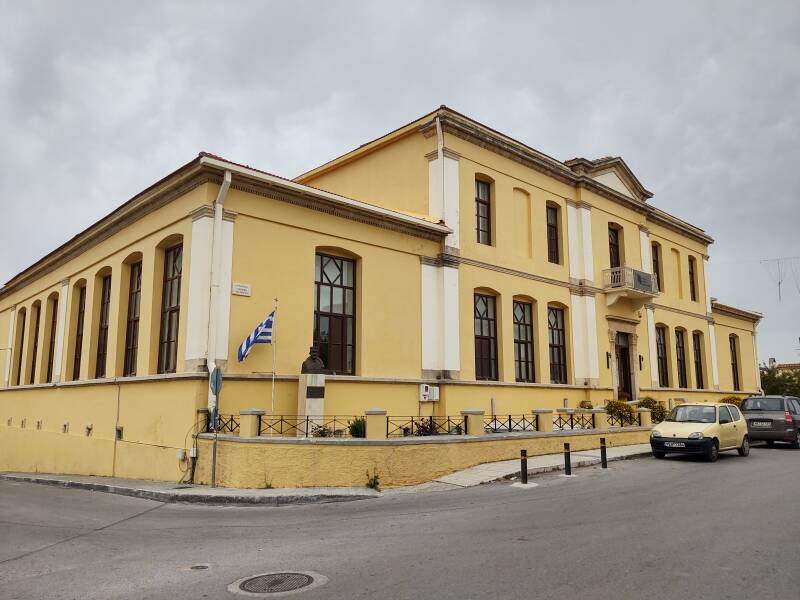
It has the grim ill-lit atmosphere I recognize from elsewhere in eastern Europe. I hope that my papers are in order.
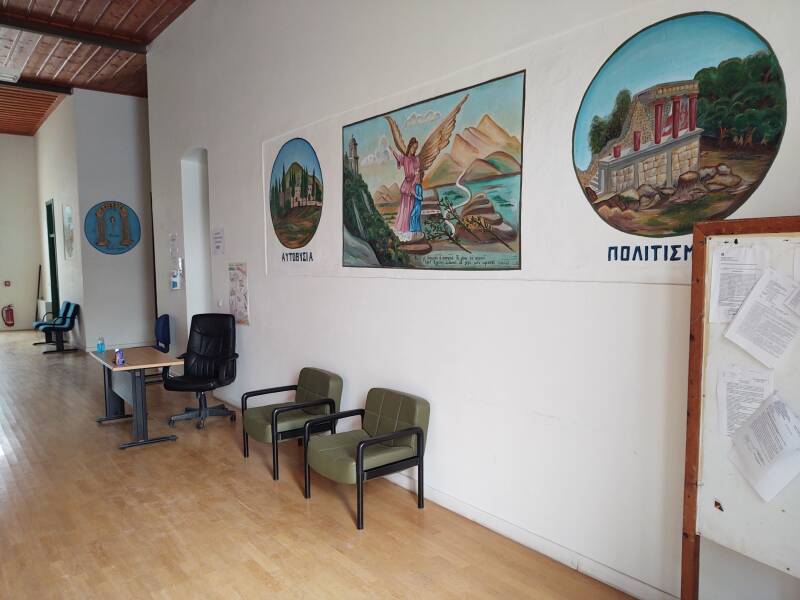
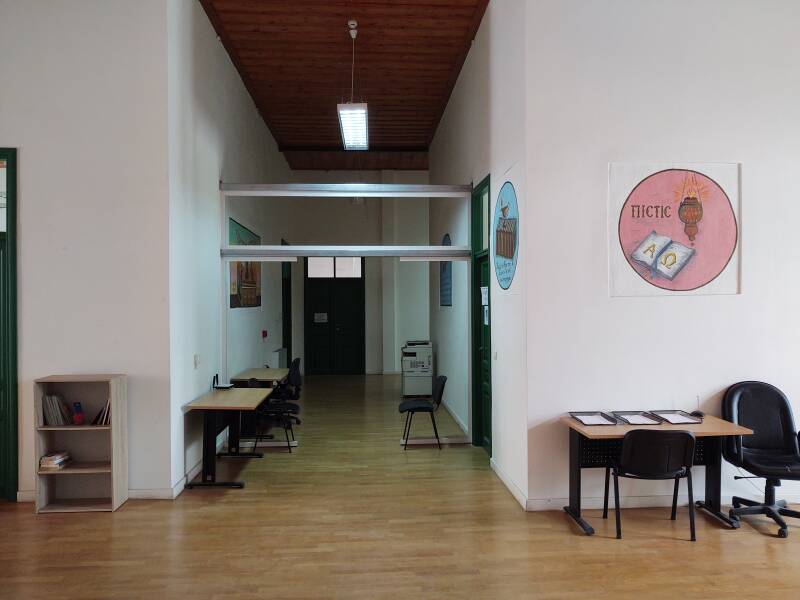
The Germans had also seized Villa Ariadne. This was a large home built in 1905 by Sir Arthur Evans, who led the in-depth investigation of Knossos. The Germans made it their commander's home.
Kreipe left his headquarters in Ano Archanes at 21:30 on Wednesday 26 April 1944, headed for a late dinner at Villa Ariadne. But British SOE officers Patrick Leigh Fermor and William Stanley Moss, along with eleven Andartes, were waiting for him. Leigh Fermor and Moss were dressed in German military police uniforms and holding a red lantern, while the Cretans were concealed nearby. Leigh Fermor and Moss stopped the car and overpowered the driver and Kreipe with the help of the Cretans. The two British officers got into the car, with Moss driving and Leigh Fermor wearing the general's hat, and three of the partisans packed into the rear seat along with the general. Eighteen days later the general would be loaded into a British submarine along the southern coast of Crete, and transported to British-controlled Cairo.
The abduction point is still a road intersection, today a traffic circle, at: 35° 15' 15.69" N, 25° 10' 56.59" E. A memorial to the abduction stands beside it.
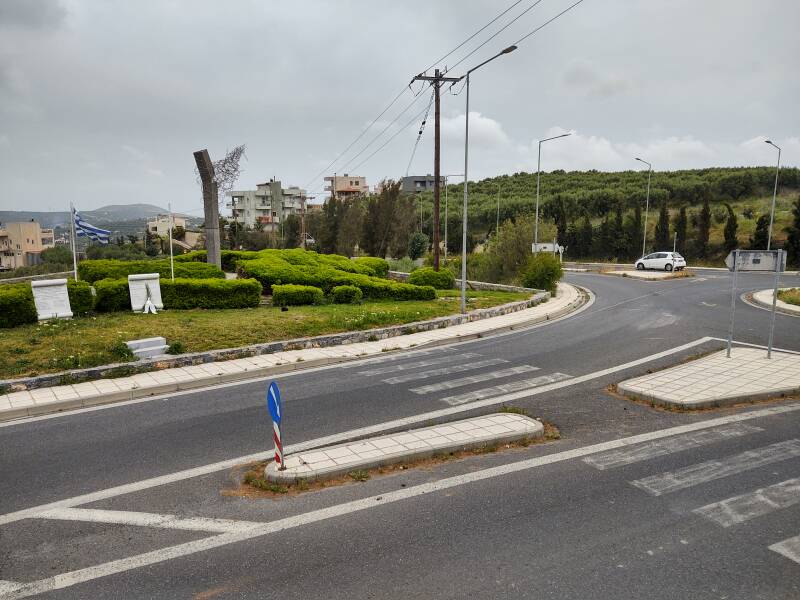

This is the place where the German General Heinrich Kreipe, Commander of the German Occupying Forces on Crete, was abducted. The operation was held by SOE Agents in association with fighters of Greek Resistance on April 26th, 1944.
The abduction members were the British Commissioned Officers:
Major Patrick Leigh Fermor
Captain William Stanley Moss
and the Fighters of Greek Resistance:
Athanasakis Ilias
Akoumianakis Michail
Zografistos Pavlos
Zoldakis Antonios
Komis Nikolaos
Papaleonidas Antonios
Paterakis Emmanouil
Saviolakis Efstratios
Tzatzas Dimitrios
Tyrakis Georgios
Chnarakis Grigorios
About 600 meters south of the abduction point in the direction of Ano Archanes and the German headquarters is a building marked as having been a museum. When I was there, that building was vacant and looked more like an unused restaurant. Beside it, right along the road, was a screened structure sheltering some vehicles.
There's a small armored vehicle, three military motorcycles, a small military car, and an Opel of the same model used by General Kreipe. It's not his car, but it's one just like it.
The plate says "KRAIPE 26-4-1943". That's an understandable way for a Greek speaker to spell "Kreipe", but the date is one year before the abduction: 26 April 1943.

The Republic of Venice ruled Crete as an overseas colony, the Kingdom of Candia, starting with the Venetian conquest in 1205–1212. Candia or Chandax was the name for today's Heraklion. Venice ruled Crete until it fell to the Ottoman Empire in the Cretan War of 1645–1669.
Yes, both ends of that period were multi-year wars, with the Cretan War lasting for 24 years. The Ottomans captured most of Crete in the first few years of that war, but Candia or Heraklion withstood a 21-year siege from 1648 to 1669, the second-longest siege in history.
The Venetians built this aqueduct at Spilia, which is along the route from the abduction point to Knossos and onward to Heraklion.
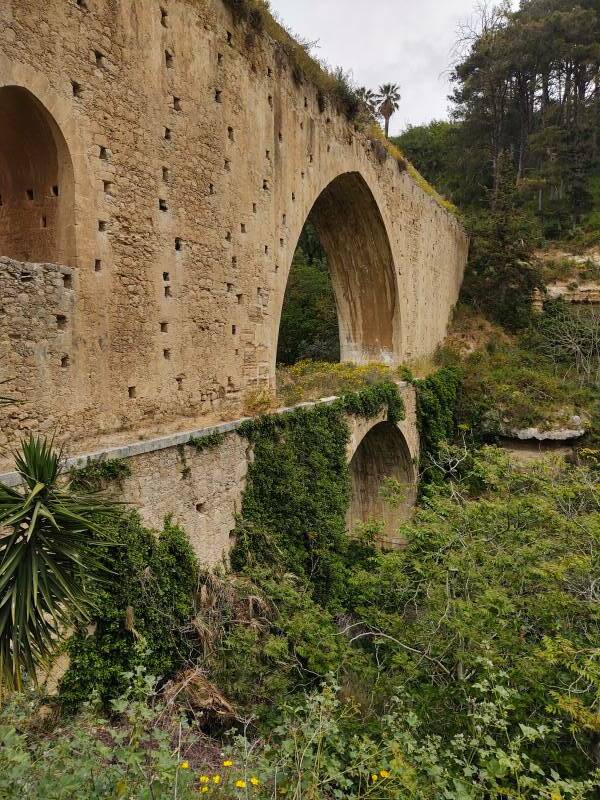
This is the view from the road bridge the team would have crossed on their way from the abduction to Heraklion.

its plumbing
The road to Heraklion continues up a long hill past the Minoan site of Knossos, home to what is commonly described as the first civilization in Europe.
Villa Ariadne was built as the home of Sir Arthur Evans, the initial excavator and interpreter of the ruins of Knossos. It was then seized by the Germans for use as their commander's home. Kreipe was driven right past the driveway into his home.
In Leigh Fermor's description, Kreipe was moaning that his military career was now over. Um, as a Major-General in the Nazi Wehrmacht in mid-1944, one's military future is already pretty bleak. But sure, worry about that.
Villa Ariadne was open to the public at least until the 2000s, but by 2022 it was permanently closed and had become a private home. Villa Dionysos is a Roman-era ruin, back the same lane and also permanently closed to visitors.

Kreipe asked where they were taking him, and was told Cairo. He said yes, I know, you told me that, but where are we going now? He was astonished to hear that they were driving into Heraklion.
The abduction team drove into the heavily fortified and German-controlled city of Heraklion, which certainly was the least expected route. They passed through twenty-two German checkpoints on their way into, through, and out of Heraklion. They were in the general's car with his standards flying from the front fenders. Kreipe was well known to be impatient with checkpoints. Leigh Fermor was in the front passenger seat wearing the general's hat, and would shout "GENERALS WAGEN!" out the window if any checkpoint threatened to stop them. It worked! Fortune favors the bold.
Guesthouses at Booking.comThey left the walled city by the Chania Gate, seen below. I had been staying at the Intra-Muros Hostel, just a short distance in from this gate. The Best Way travel company stores its rental cars in a nearby garage, so I was able to pick up my car at the hostel.
I would drive out through the Chania Gate in the direction we're looking here, following the old road from Heraklion toward Chania. An expressway now follows the shoreline, but I'll be inland, inside the coastal range of mountains.
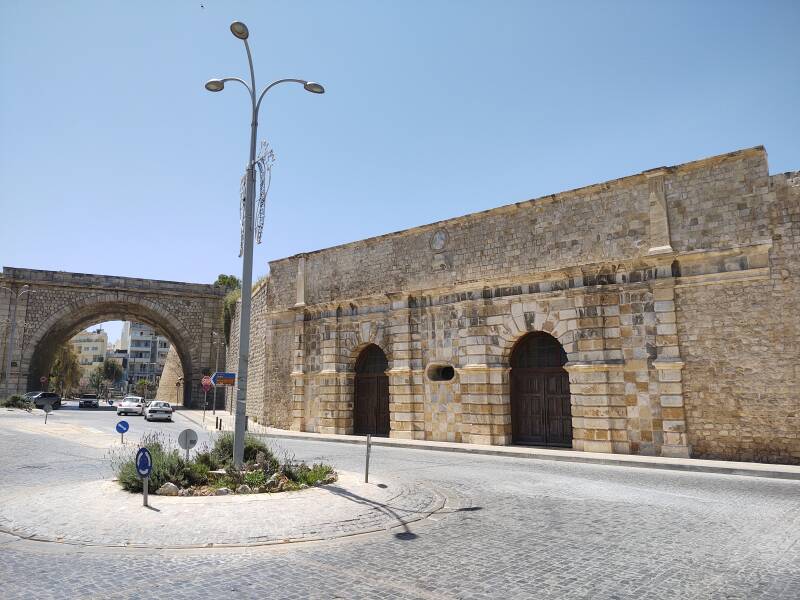
The heavy city walls were built by the Venetians when they controlled Crete. Nikos Kazantzakis' grave is now on top of it. He wrote Zorba the Greek and The Last Temptation of Christ and other novels, and was nominated nine times for the Nobel Prize in Literature.
Here's the view along the wall from near Kazantzakis' grave. The old city inside the wall is to the right. You can see another large gate, the Chania Gate is the next gate beyond it, the last one toward the waterfront.
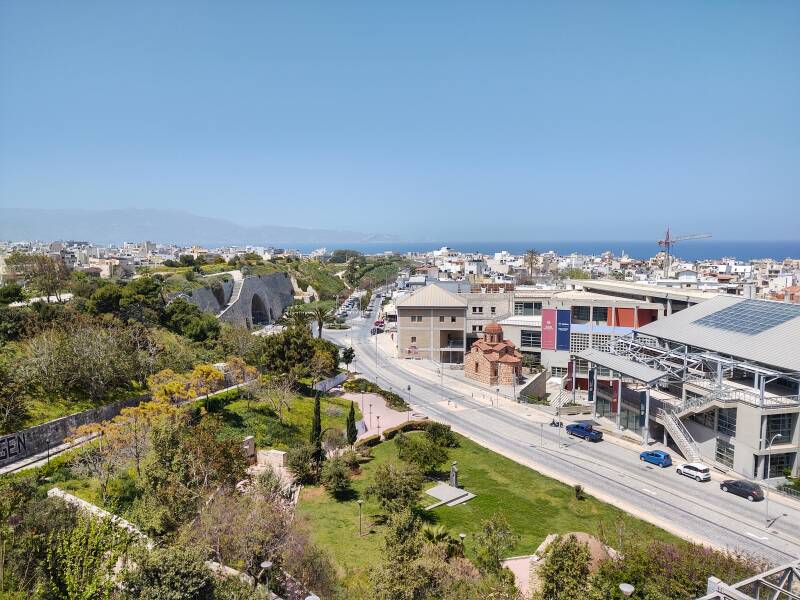
Δαμάστα — Damasta
The first point of specific interest that I came to was the village of Δαμάστα or Damasta. It's on the old highway between Heraklion and Chania, 245 people lived here at the 2011 census.
SOE officer William Stanley Moss, who took part in the Kreipe abduction, was sent back to Crete after that operation with the SBS or Special Boat Service, to provide guides for the SBS and carry out a diversionary attack. The SBS landed the night of 1/2 July, carried out attacks on the night of 22/23 July in which they destroyed about 150,000 gallons of fuel and several military vehicles, and were extracted by 29 July.
Moss had planned an ambush on this road with a small group of Andartes and some escaped Soviet POWs who had joined the Cretan Resistance. On 7 August 1944, the German garrison based on Yeni Gave, an Ottoman Turkish name spelled Γενί–Γκαβέ in the Greek alphabet and now known as Drosia, went to Anogeia to round up villagers for forced labor. The villagers refused to cooperate, so the Germans took fifty of them as hostages and started for Rethymno. Along the way local guerrillas attacked, freeing the hostages and killing all the Germans.
Friedrich-Wilhelm Müller, "The Butcher of Crete", would obviously launch reprisals. The villages fled into the mountains with the local Andartes.
The next day, Moss led an attack with eight Cretans from Anogeia and six escaped Soviet POWs. They set up an ambush at a small bridge one kilometer west of Damasta, mining it with grenades. They destroyed a variety of German military vehicles before the main German force headed for Anogeia finally appeared. It was a truck of infantry with an armored car.
Moss' force killed 35 Germans and 10 Italians, and took 12 Axis prisoners. Moss had climbed up onto the armored car and dropped a grenade into its hatch.
As a reprisal, on 21 August the Germans marched 30 men from Damasta about one kilometer east of the village along the road, then up this slope to where they executed them. Then they returned to the village and destroyed it.
This memorial is on a tight turn about a kilometer east of the village, before you reach it on the way from Heraklion.
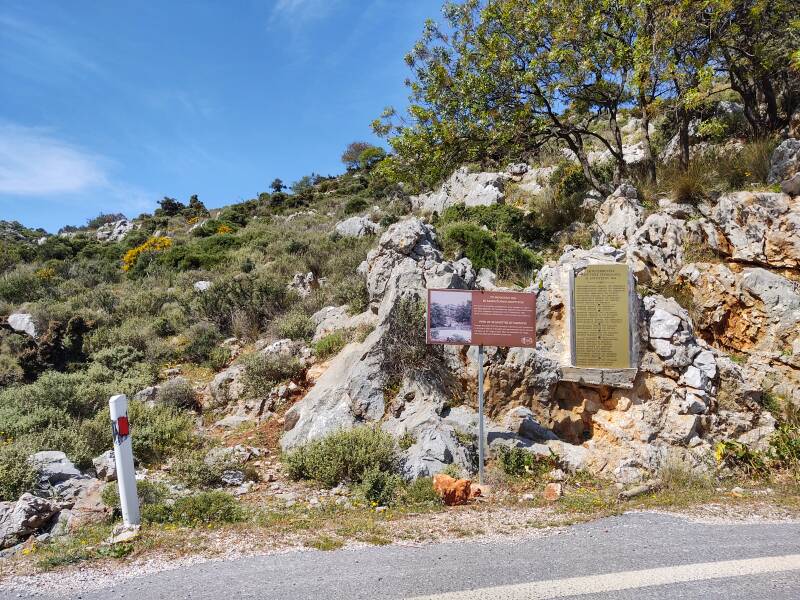
The Damasta sabotage, and the German reprisals that followed, are described in Moss' book A War of Shadows.
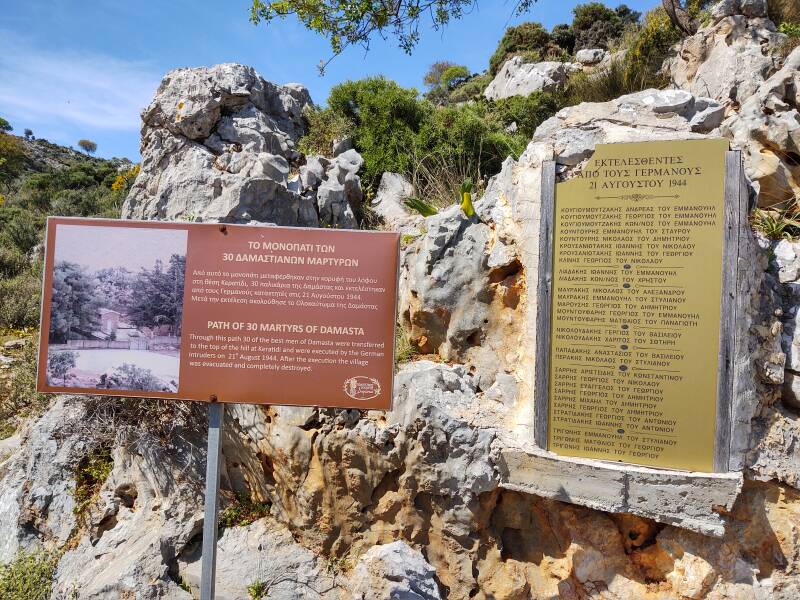
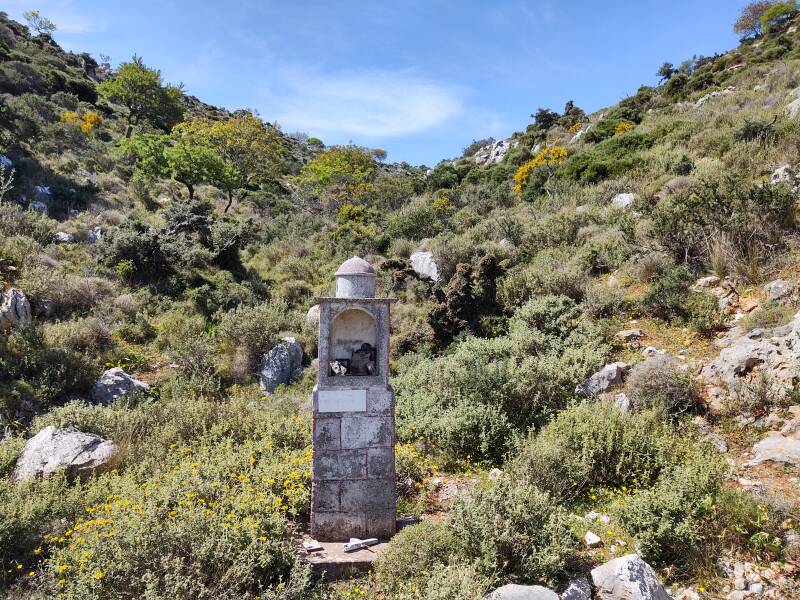
Moss had hoped that the ambush might save Anogeia. But of course Müller used it as an excuse for further reprisals against civilians. Plus, as he made obvious soon afterward, he wanted to punish Anogeia for its years of resistance.
I drove through the village and parked at its western edge, then walked back to its east end and walked through it taking some pictures. I'm approaching the sign at the east end of the village.

Yes, back in the 1940s this was the main east-west highway in Crete. An expressway running along the coast now joins Chania to Heraklion, and continues east to Agios Nikolaos and Sitia.
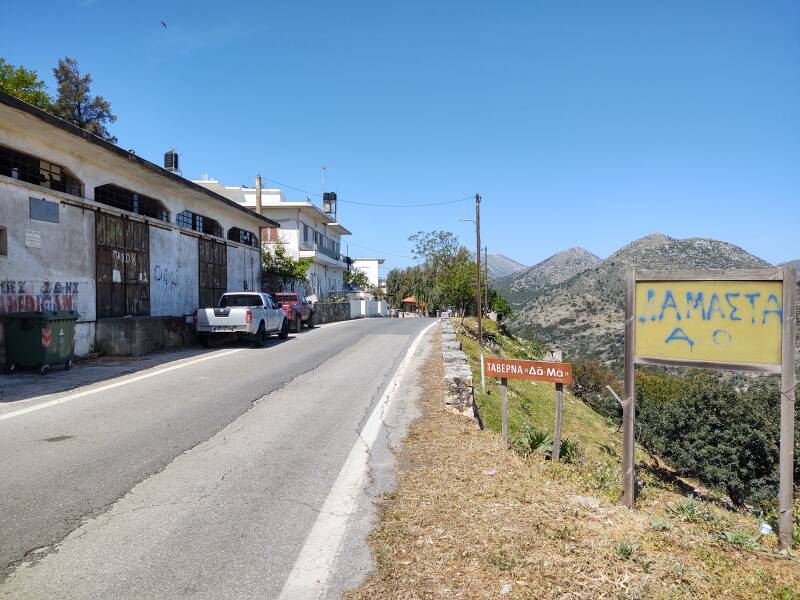

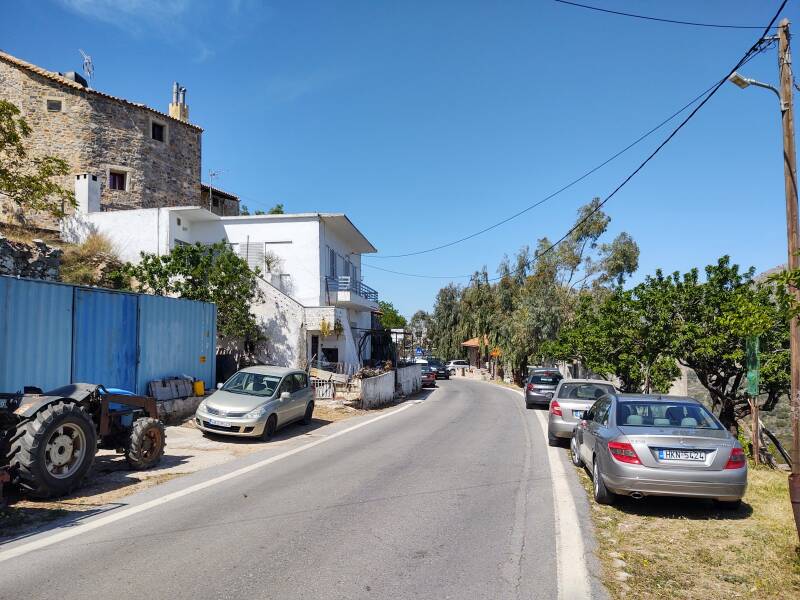
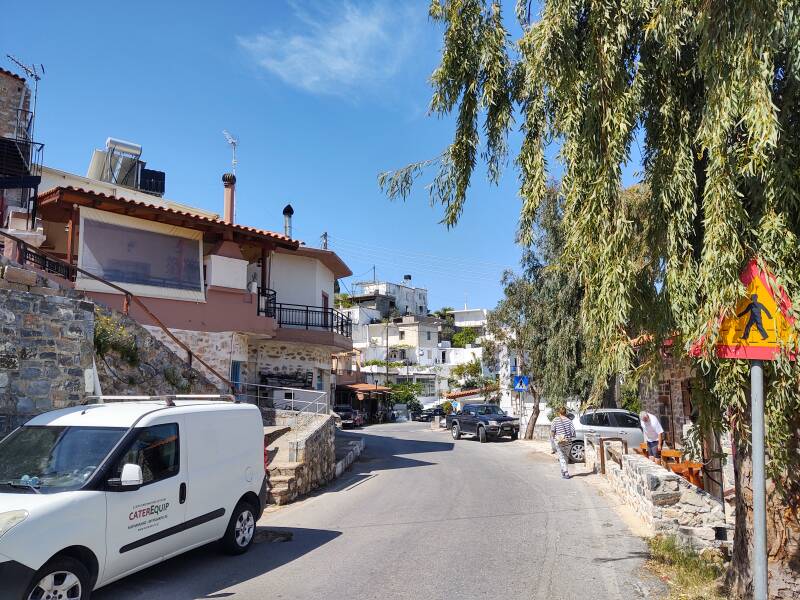

A memorial stands along the road at the center of the village.

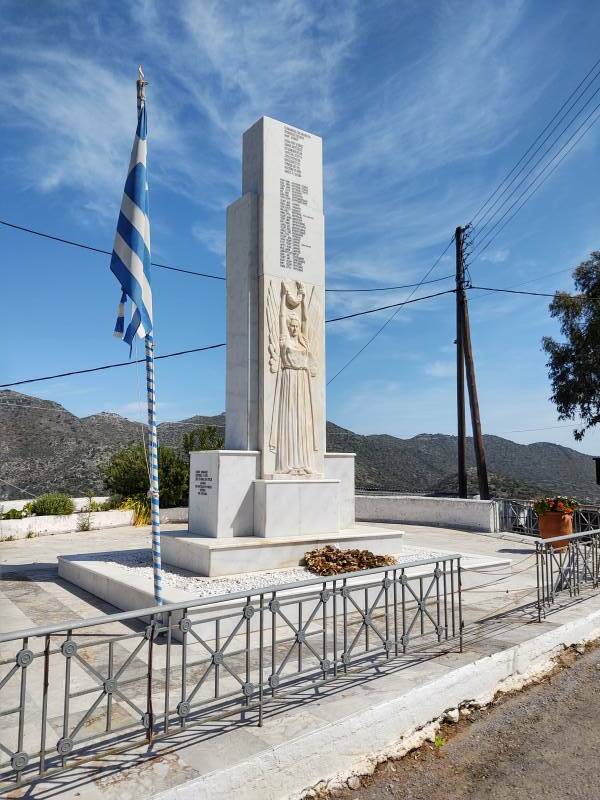
I soon reached my car and continued. A memorial at the attack site is about another kilometer to the west.
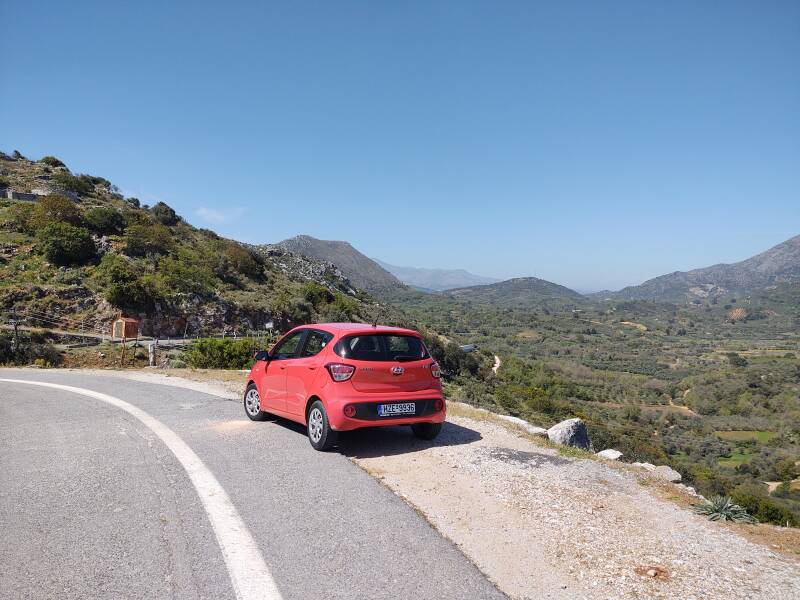
Here is the memorial.

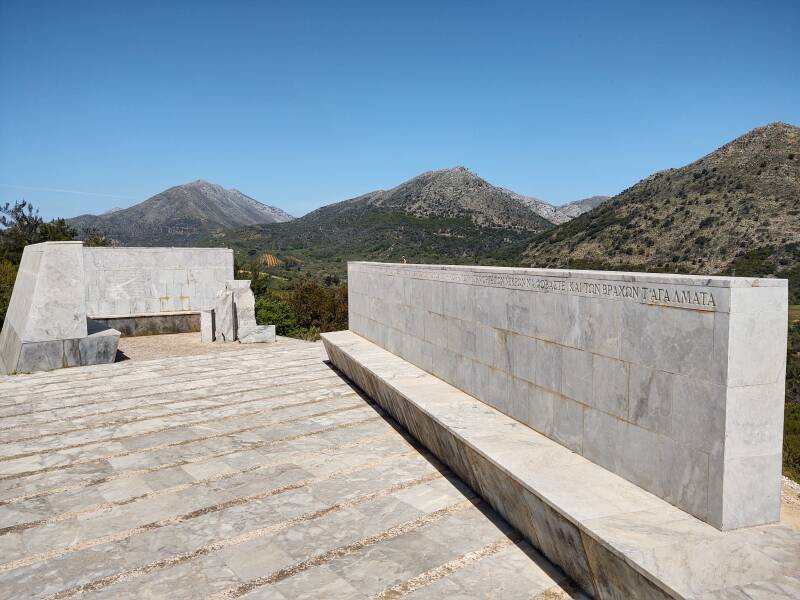
The monument includes a fragment of a poem written by the Greek poet Odysseus Elytis, winner of the 1979 Nobel Prize for Literature. An English translation of the extract engraved on the monument is:
THEY PIERCE IT WITH A HARDENED SCALPEL
THEY CARVE MY STONE WITH A BITTER CHISEL
AND THE MORE TIME ERODES MATTER THE CLEARER THE ORACLE COMES OUT OF MY FACE:
FEAR THE WRATH OF THE DEAD AND THE STATUES OF THE ROCKS!
An engraved block describes the events:
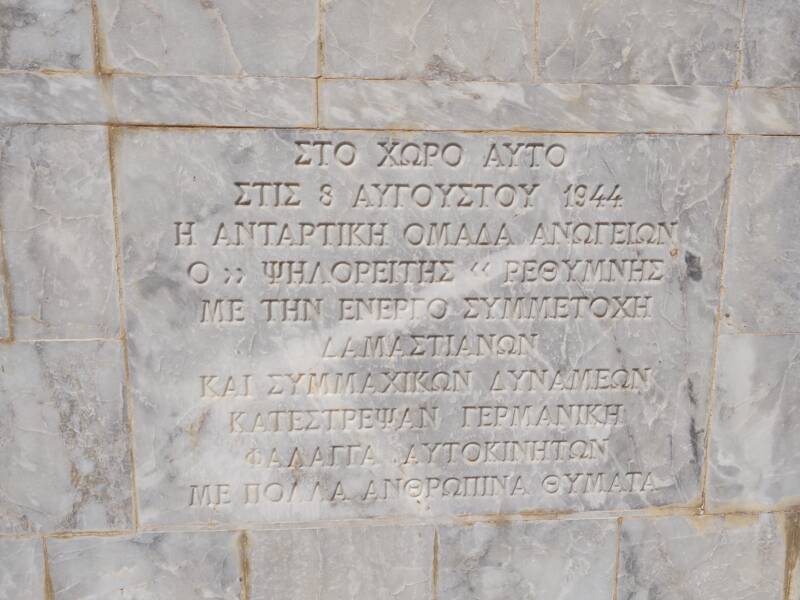

Then I continued west toward Drosia.

Δροσιά — Drosia
During World War Two the village was still known by its old Turkish name from the days of Ottoman control — Yeni Gave, spelled Γενί–Γκαβέ in the Greek alphabet. "Yeni" is Turkish for "new", and γκαβέ is Greek for "gave", and beyond that I have no idea of what this Greco-Turkic mashup of a town name might mean.
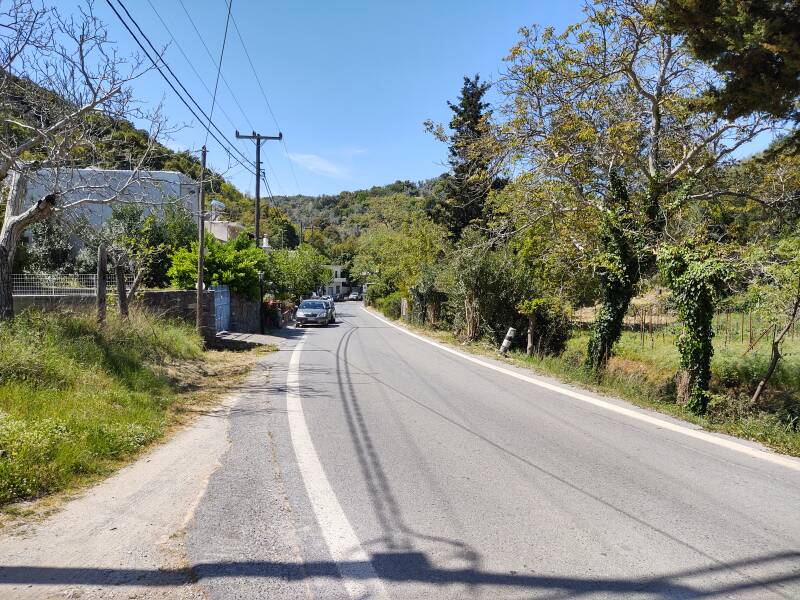
Slow down when you drive through villages, it can be a tight fit.
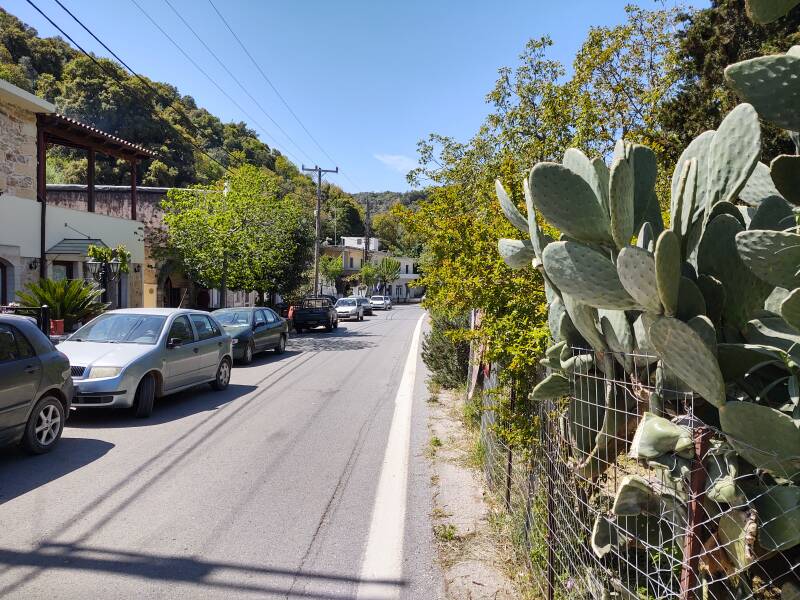
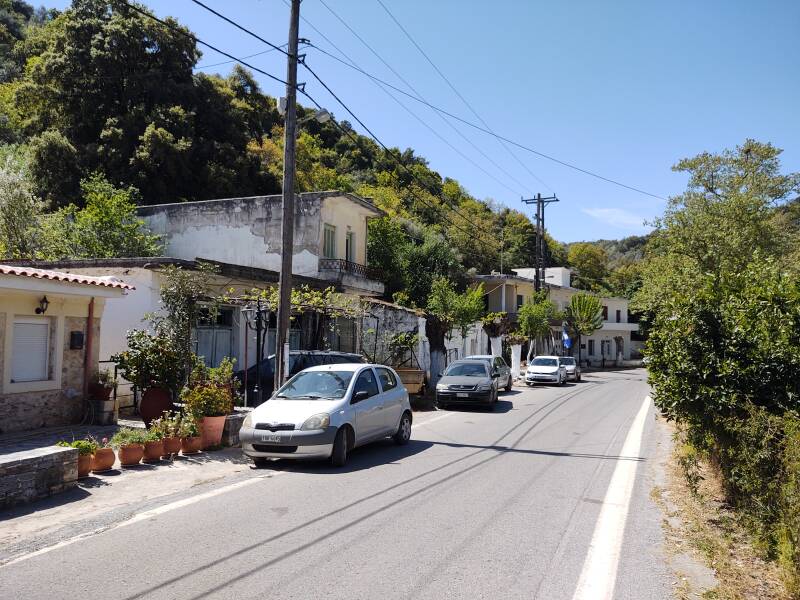
Villagers were enjoying coffee at some small tavernas.
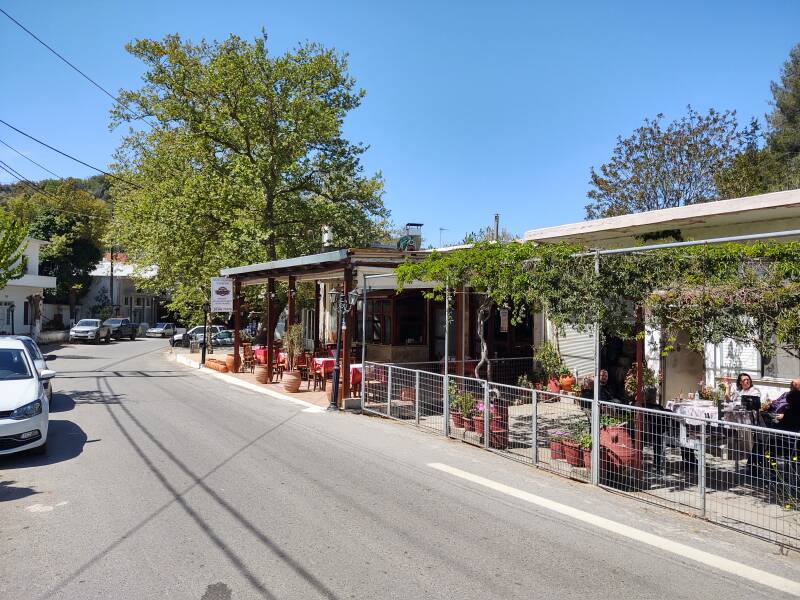
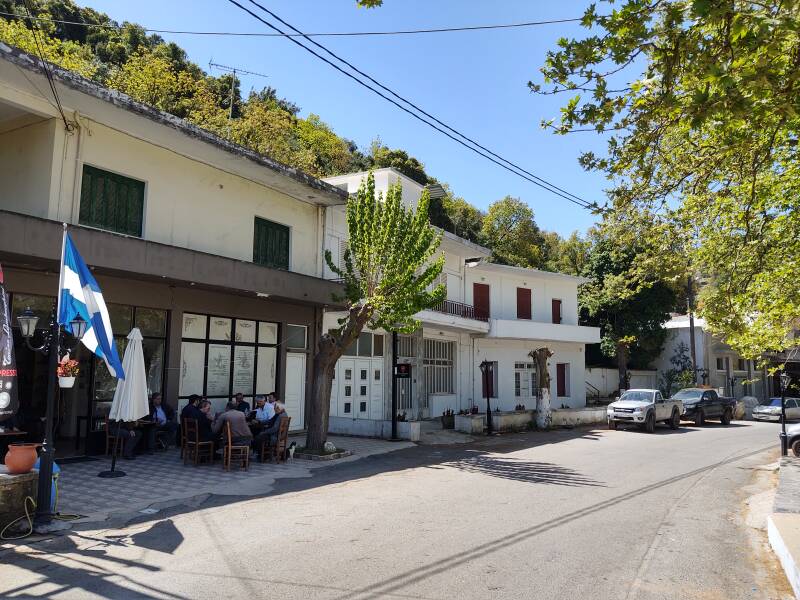

A bulletin board near the center lists upcoming funerals.
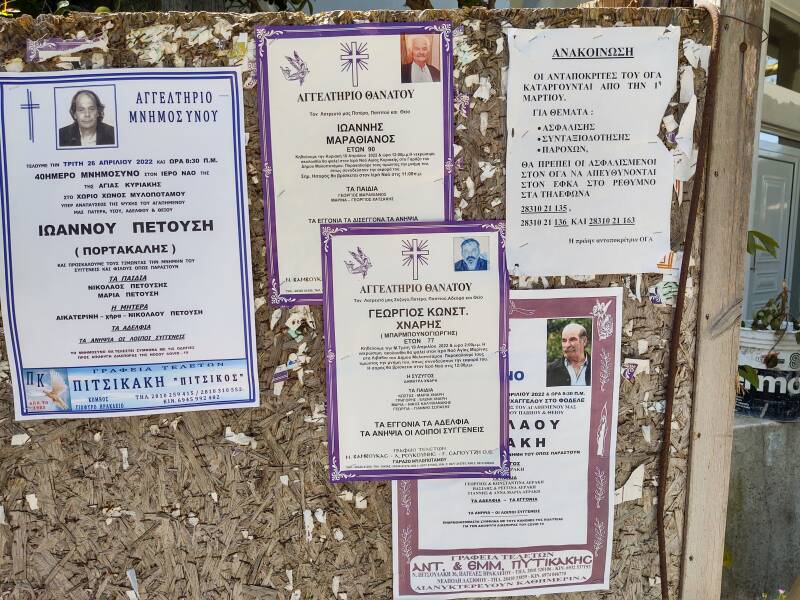
Moss stopped the car in the center of Drosia. He and several Andartes would start south with General Kreipe, walking overland up into the mountains toward Anogeia.
Leigh Fermor (who wasn't at all familiar with driving a car) would drive the car on to Doxaro, accompanied by George Tyrakis, one of the Andartes. They would abandon the car at Doxaro, leaving a letter to the Germans pinned to the driver's seat. The letter would say that it was an entirely British operation with no help from the Cretans. British cigarette butts and an Agatha Christie paperback added to the effect. The car's position, contents of the letter, and some other intentional evidence were hoped to give the suspicion that they had instead gone north through a pass to the nearby north coast to be picked up by a small boat taking them to a submarine. Then they would trek overland to the southeast to a site near Anogeia and rendezvous with the others.
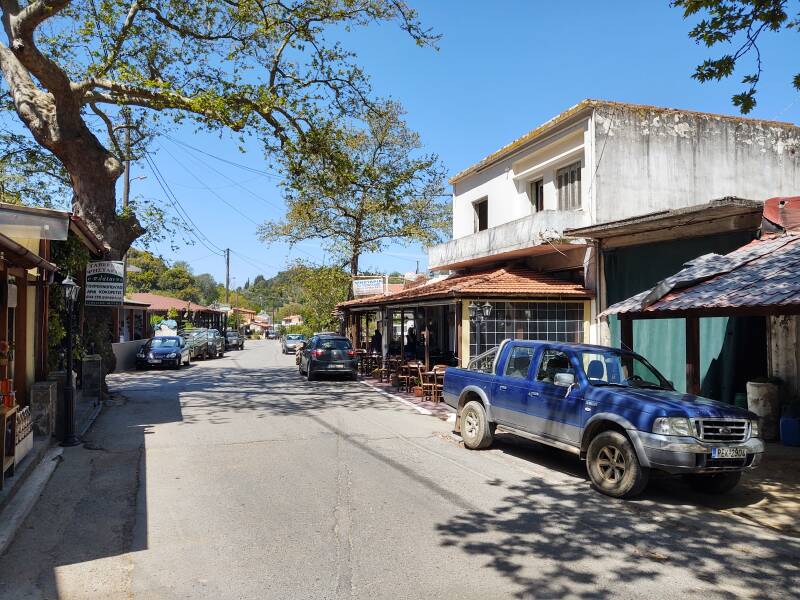
"Local Eggs" the sign says, and there's a display of local honey.

This fountain near the center is a remnant of Ottoman days.

Δοξαρό — Doxaro
The very small settlement on the road is Κάμπος Δοξαρού or Kampos Doxarou, meaning Doxaros Plain. The village of Δοξαρό or Doxaro was about 300 meters to the north. Today this church and a few houses are the extent of Kampos Doxarou along the road.
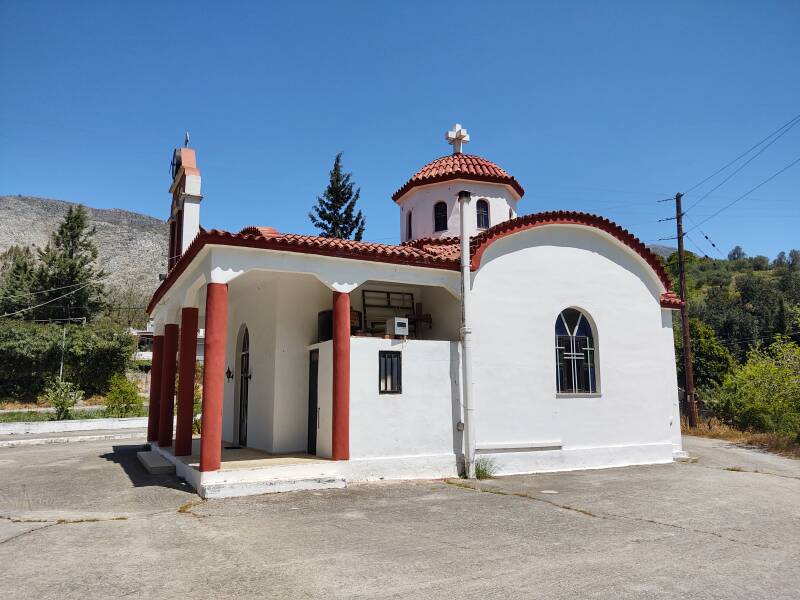
The remains of Doxaro village are up this track. Patrick Leigh Fermor and George Tyrakis left the car near here.

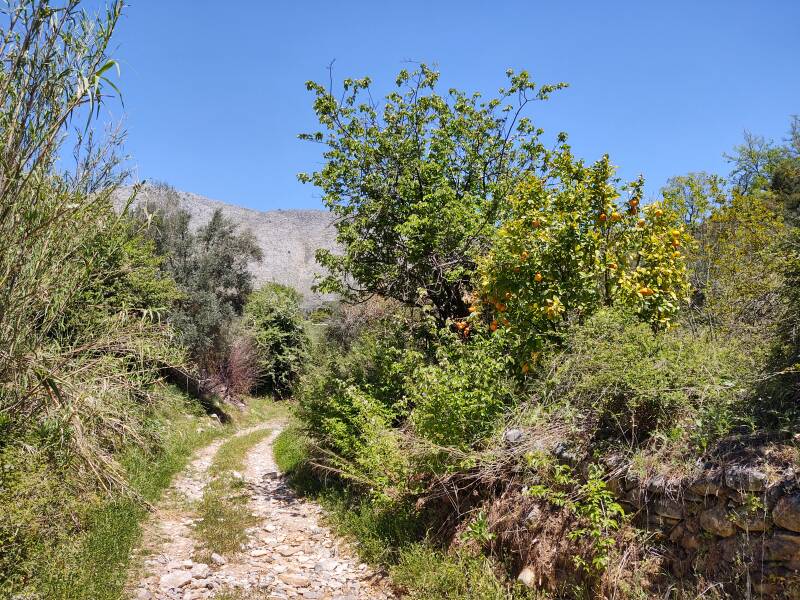

Turning to look south from near the village, you can see the Mount Ida massif. My visit happened to be in late April, within a few days of when the abduction took place. Ida was similarly snow-covered at this time in 1944, making for a difficult traversal.

Today there's a road along what then was the herders' path that they wanted the Germans to believe they had taken to the north coast.
Watch out for the pedestrians.
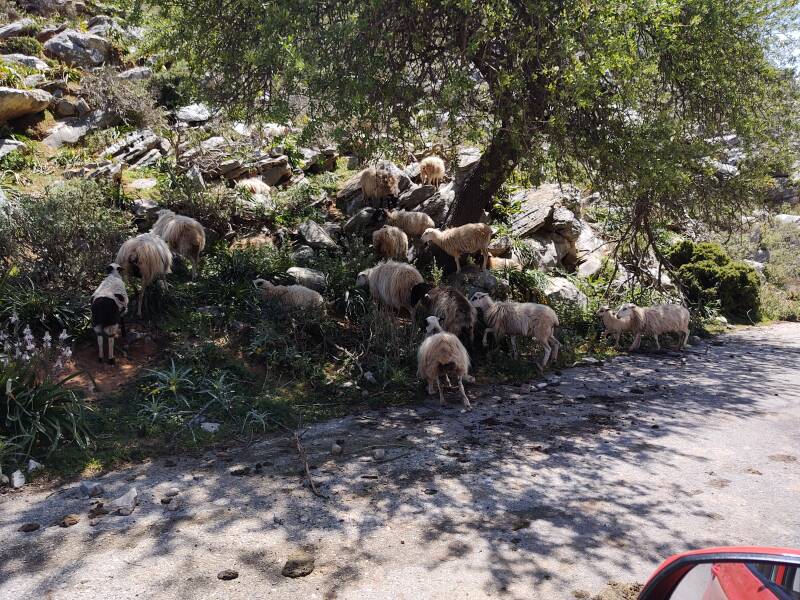
From the pass there's a great view back to the south.

Αγριδιά — Agridia
I returned to the east-west road, then turned south on a side road that led through the village of Agridia.

The saddle in that distant ridge is the pass from Doxaro to the north coast, the purported "escape route" where the car was abandoned.
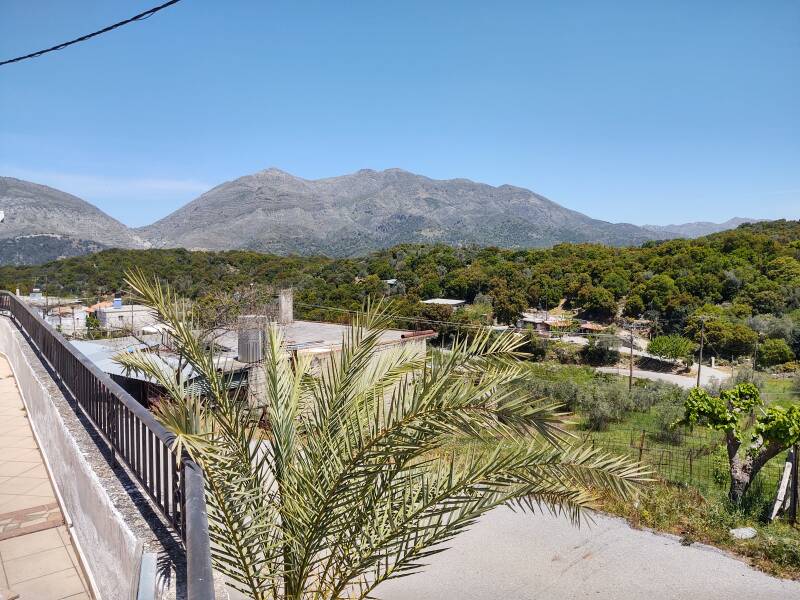
Then it was on north into the mountains.

They had to traverse these steep-sided gorges in the night, leading the captured General Kreipe.

Αξός — Axos
Axos is extremely old. It has also been known as Όαξος or Oaxos or Oaxus, and Ϝάξος or Waxos or Waxus. The church incorporates a piece of white marble with a burial inscription in the ancient Doric Greek language used in Crete around 800–100 BCE. Its Mycenaean name has been found in Linear B tablets in the form 𐀁𐀒𐀰 or e-ko-so. And before that, it was a Minoan settlement.
I have stopped at a church at the edge of Axos and am looking back down over how I approached along a twisting road.
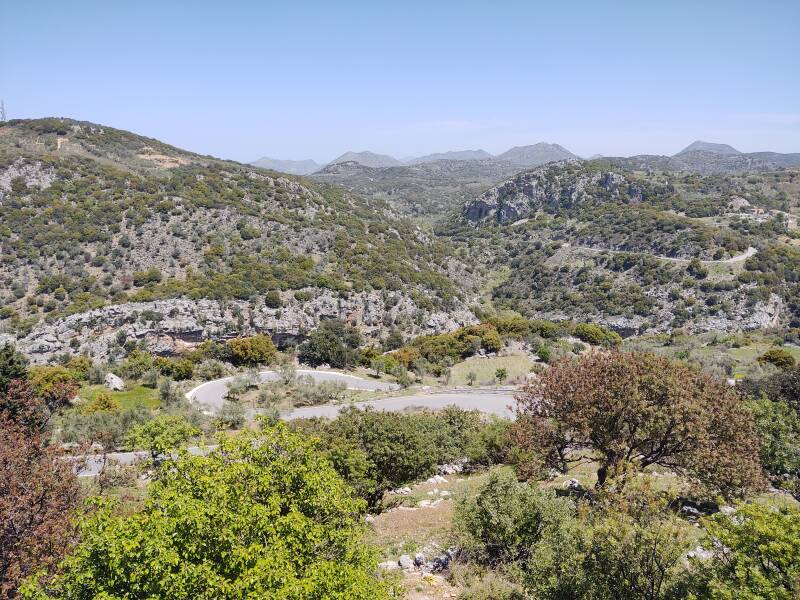

A tiny chapel stands in the courtyard.
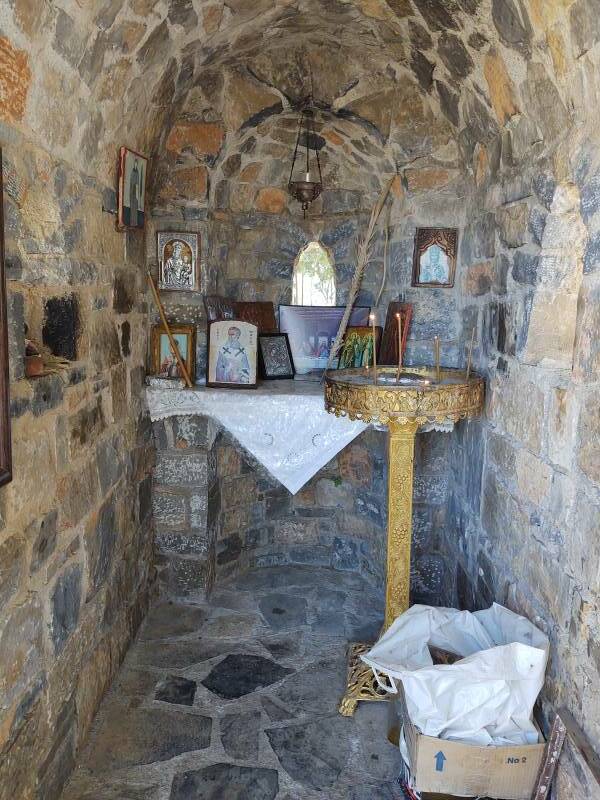
Just as on the iconostasis of a full-sized church, the altar is flanked by two specific icons. To the left is the Παναγία or Panagia, depicting the Θεοτόκος or Theotokos, the God-Bearer Virgin Mary, holding baby Jesus in a specific pose. To the right is the Χριστός Παντοκράτωρ or Khristos Pantokrator, "Christ Almighty" or "Christ All-Powerful". The idea is that the first and second comings of Christ are always front and center. On an iconostasis they flank the central door or Beautiful Gate leading to the altar.
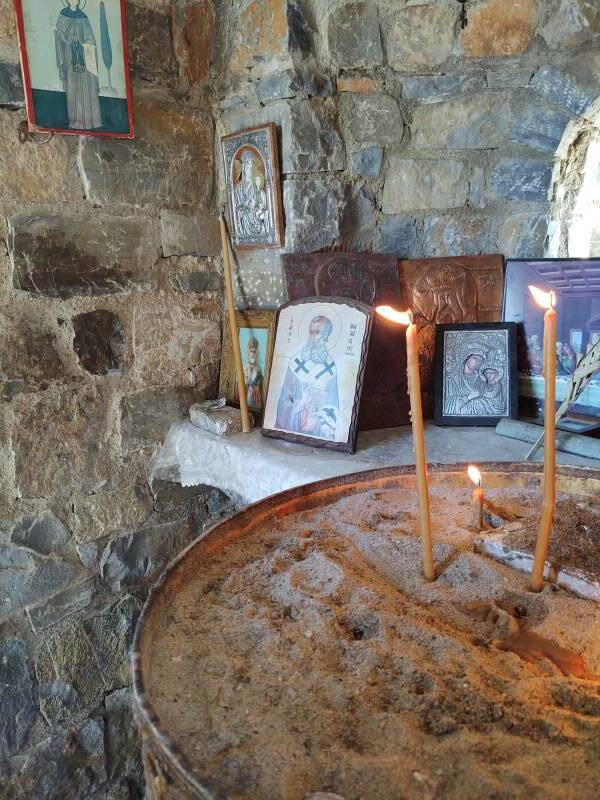

Here's one of those restaurants that spans a road.
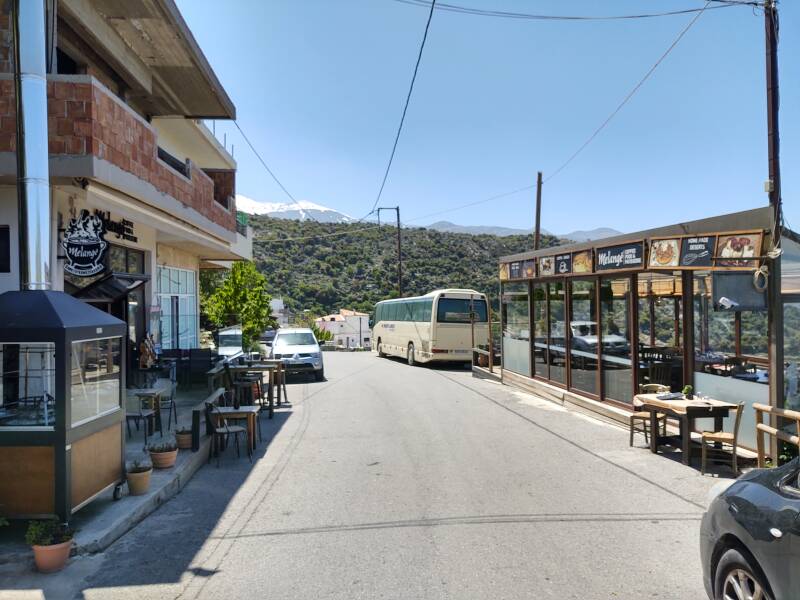
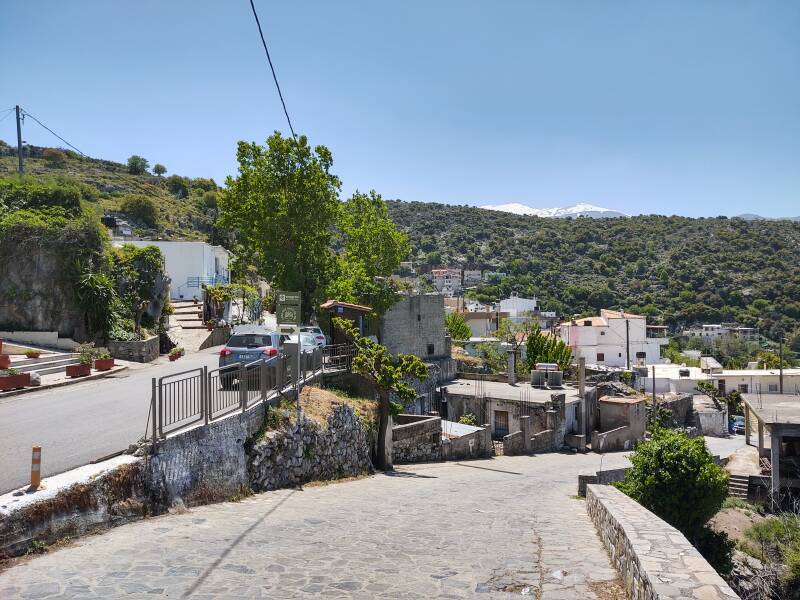
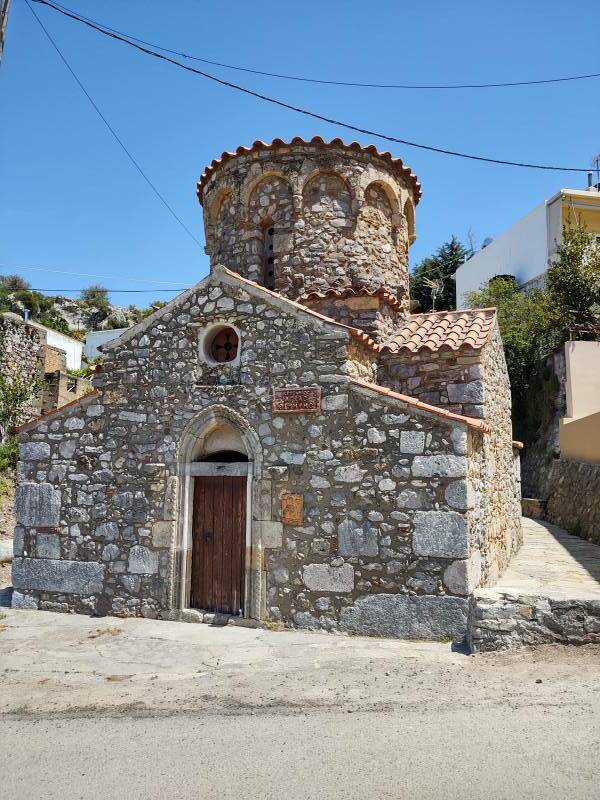
Ancient Axos is above the village, at the top of the hill. It was first occupied in Late Minoan times and was a flourishing city-state in the Archaic and Hellenistic periods.
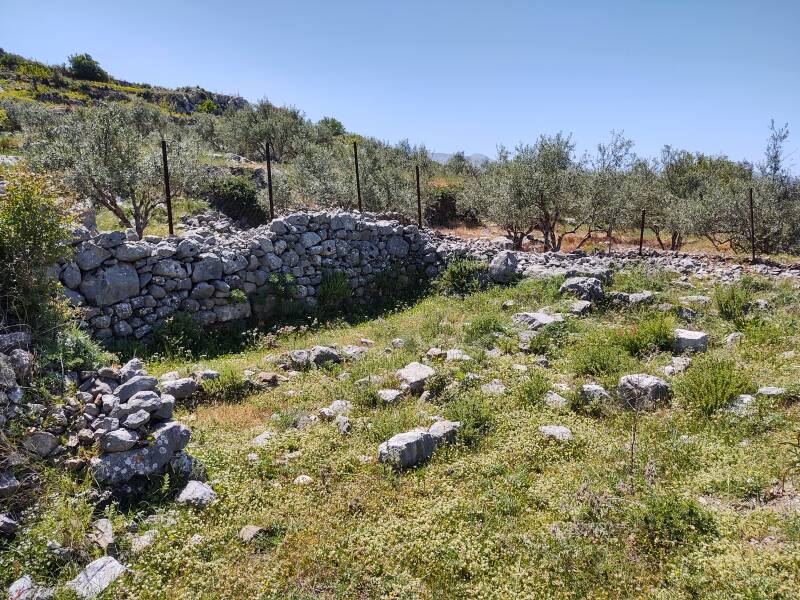
A Temple of Aphrodite was on the peak.
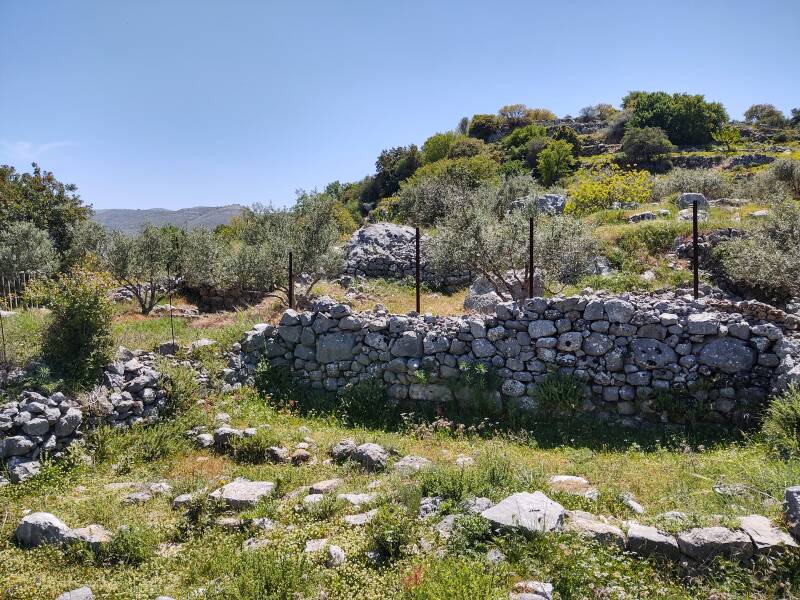
Aphrodite's temples tended to be on peaks.

And the high points remain favored sacred sites. A church and the town cemetery are just below those ruins from Minoan to Hellenistic times.

Back through the village to my car, and then onward to Anogeia.
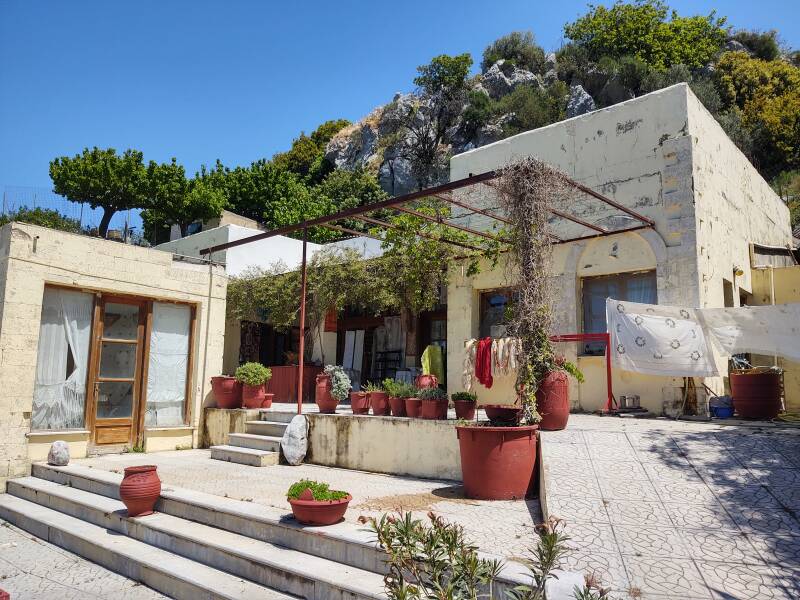
Ανώγεια — Anogeia
I continued to climb in elevation to reach Ανώγεια or Anogeia, which is at 738 meters. Its name is pronounced roughly like ah-NO-ye-yah, as the γ isn't pronounced at all like the English g usually is. English transliteration of Greek varies widely, and it retains many of the early to mid 20th century assumptions that everyone took Ancient Greek at an English boys' school, and that the reader wants the Ancient or maybe the Koine Greek pronunciation used to write the New Testament (although that pronunciation was already a little outdated before the New Testament was complete). Modern Greek spoken by people living in Greece today doesn't seem to interest English speakers nearly as much as its ancestral languages two to three millennia old.
Anogeia residents are known for their rebellious spirit and their long tradition of resisting foreign rule and sheltering rebel fighters.
Between 1941 and 1944, the German invaders killed a total of 104 Anogeians out of a population around 4,000. This memorial is in the square at the center of the village.
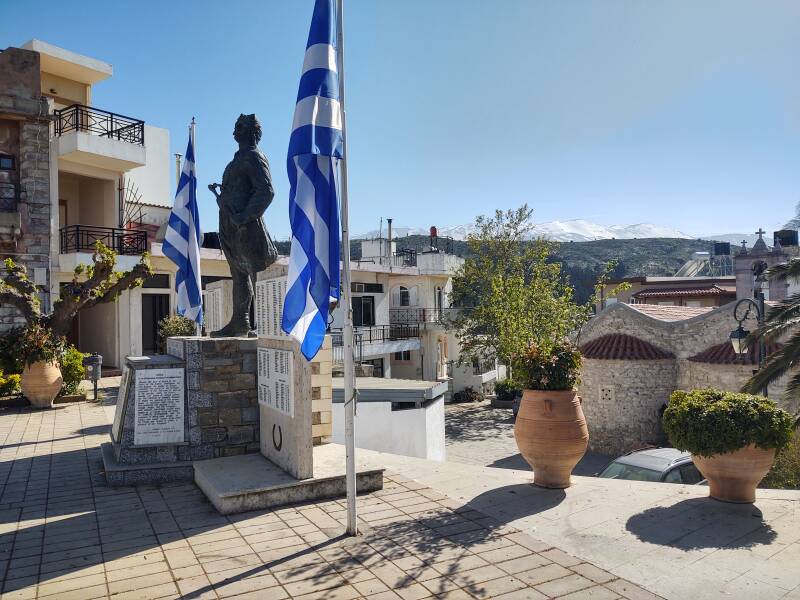
A resistance group was set up here within a month of the German invasion. Giannis Dramountanis (Stefanogiannis) and Michalis Xilouris organized the AOA or Ανεξάρτητη Ομάς Ανωγείων, the "Independent Group of Anogeia". Other residents joined the local ELAS or Greek People's Liberation Army. These resistance groups collaborated with SOE commander Lieutenant Colonel Tom Dunbabin, who provided intelligence and support. Anogeia became the core of the Resistance in Crete.
Generalleutnant Friedrich-Wilmelm Müller's reprisals were brutal. On 13 August 1944 he issued this order:
ORDER
BY THE GERMAN GENERAL COMMANDER OF THE GARRISON OF CRETE
Since the town of Anogeia is the centre of English espionage on Crete, since the people of Anogeia committed the murder of the Sergeant Commander of the Yeni-Gave, as well as of the garrison under his command, since the people of Anogeia carried out the sabotage of Damasta, since in Anogeia the guerrillas of the various resistance bands take refuge and find protection and since the abductors of General Kreipe passed through Anogeia using it as a transit camp, we order its complete destruction and the execution of every male who is found in the village and around it within a distance of one kilometre.
CHANIA 13TH AUGUST 1944
THE GENERAL COMMANDER OF THE GARRISON OF CRETE
H MÜLLER
Three battalions with about 2,000 German troops set up a perimeter. They arrested 80 elderly village residents and sent them to Heraklion, and executed nine disabled persons including six elderly women. Everyone else had fled into the mountains.
In Anogeia and Damasta a total of 900 houses were looted and then burned or dynamited, 50 civilians were shot, and 3,500 became internally displaced refugees. Then the operation expanded to other villages in the following days, with the men being executing and the houses being first looted and then burned or dynamited. The destruction and killings continued for 23 days, into early September.

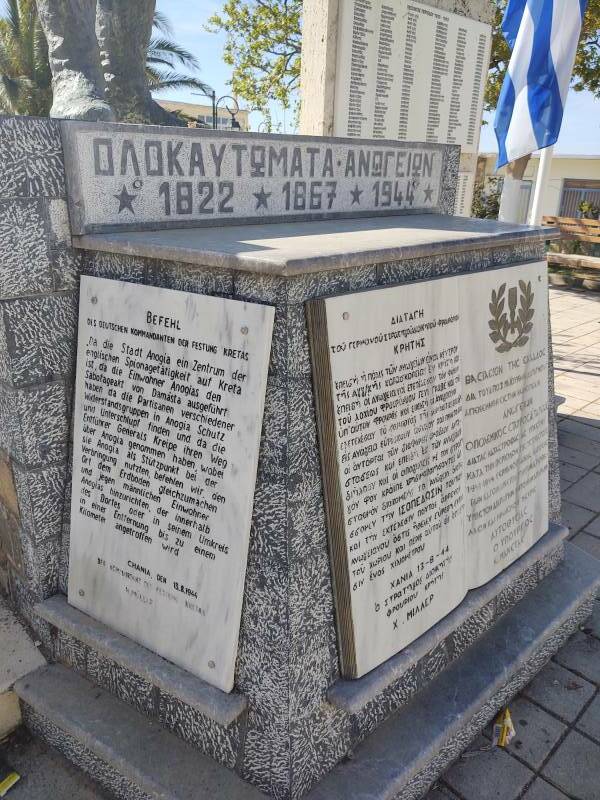
They made certain to put the original German order on the monument.
And there's an English translation for other visitors.
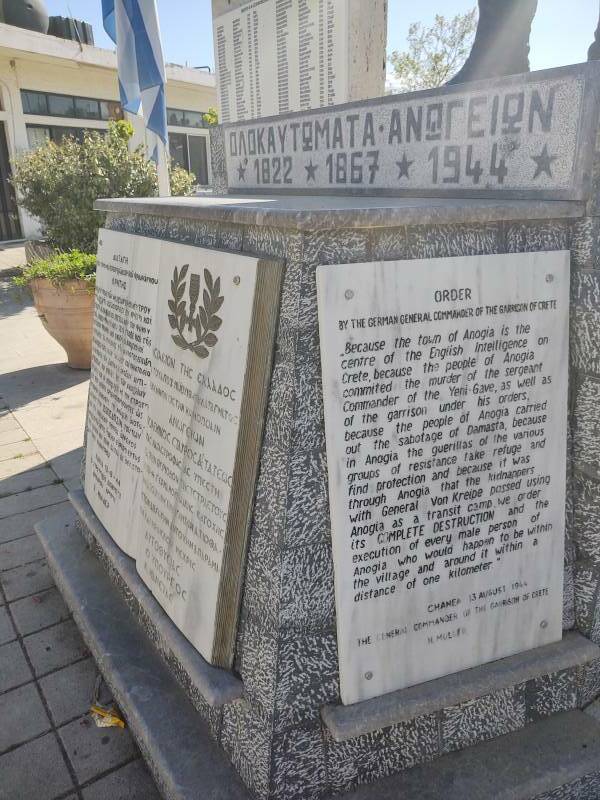
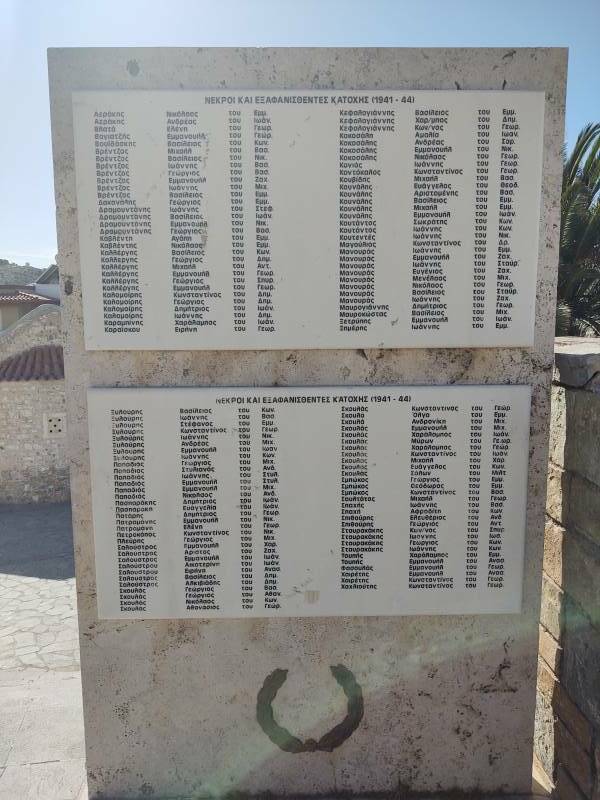

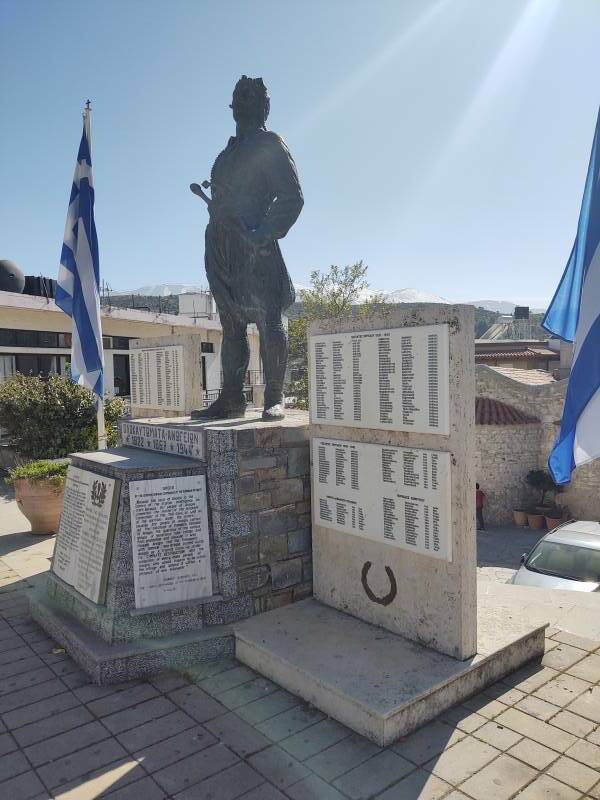

The local legends say that the original settlement was founded by villagers from Axos. Now Anogeia has been rebuilt. There were 2,379 people living here at the last census.
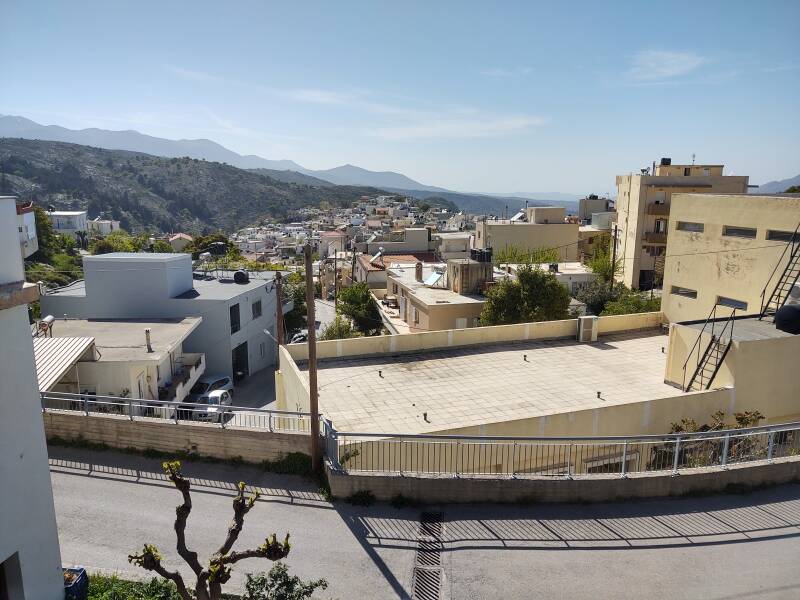
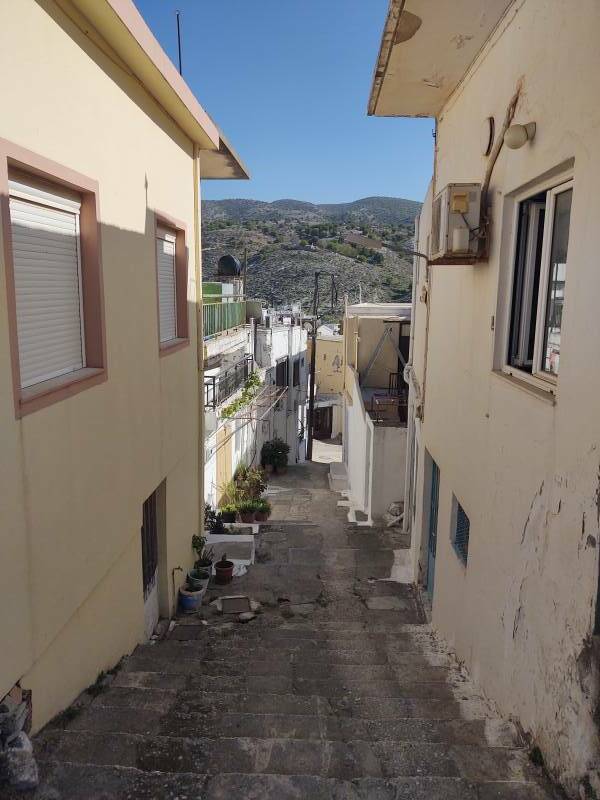
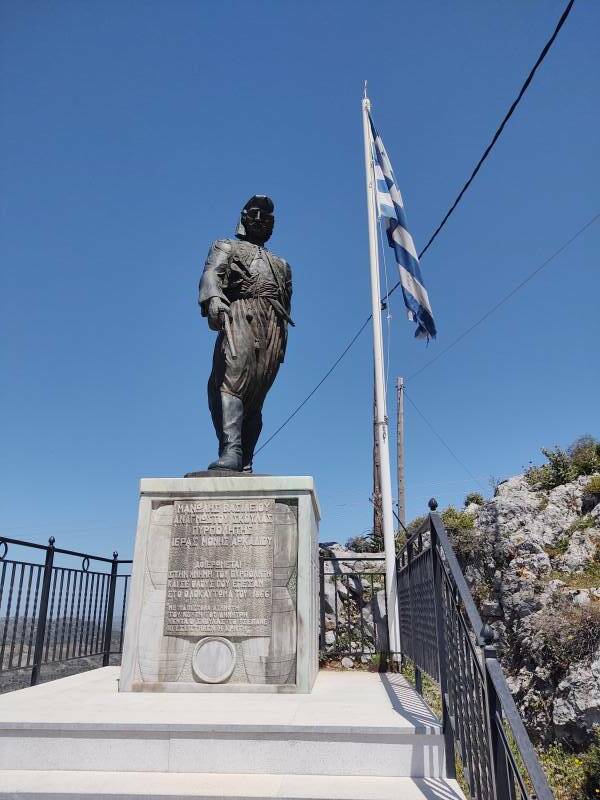
The German atrocities were the third time that Anogeia had been destroyed by occupiers. The Ottoman Turks destroyed it twice during the Great Cretan Revolt, in July 1822 and again in November 1867. And so there are monuments to other Resistances against other invaders.
Here is a nice taverna where I will get a late lunch.

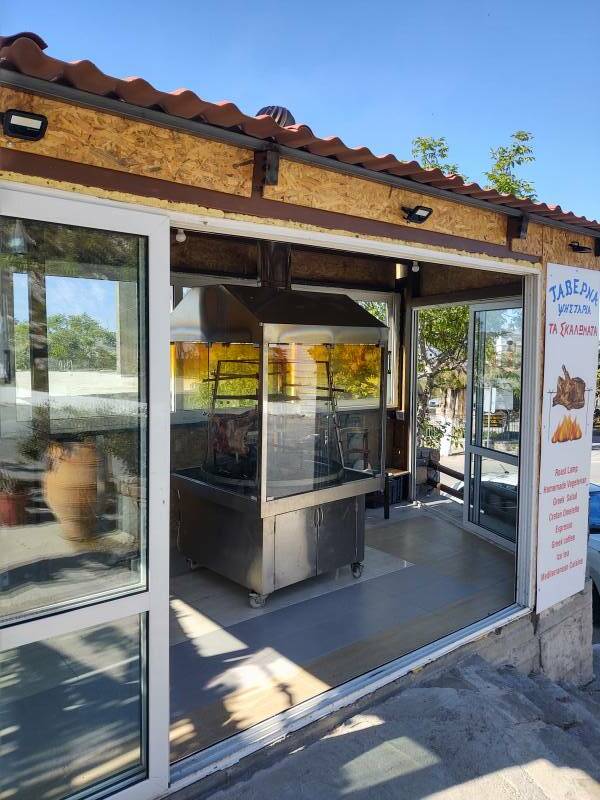
The lamb is grilling! This was the Monday after Easter, so many businesses were closed. But many tavernas were open and roasting lamb.
The specialty is lamb οφτό or ofto, roasted over a fire.
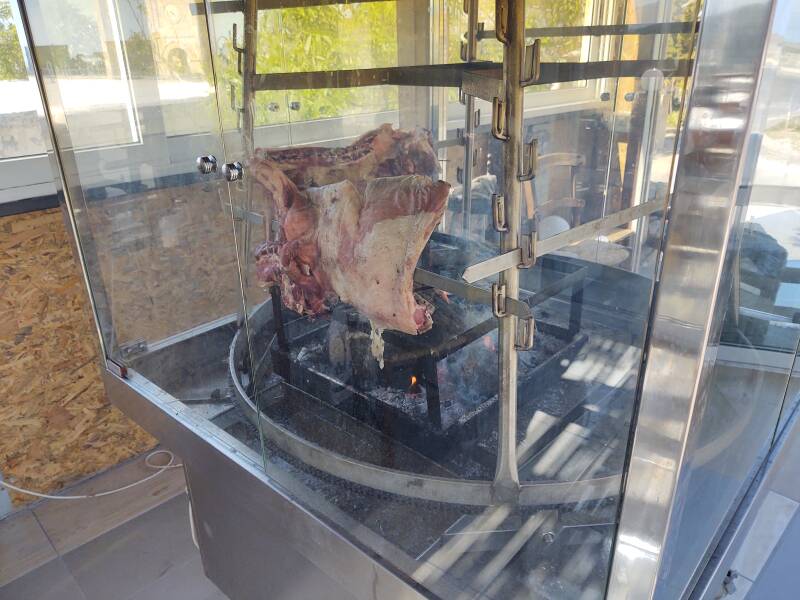
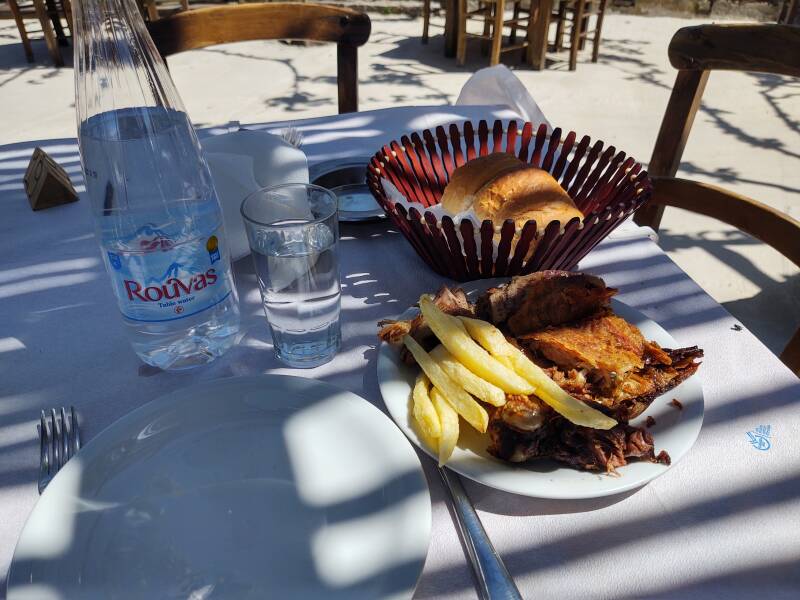
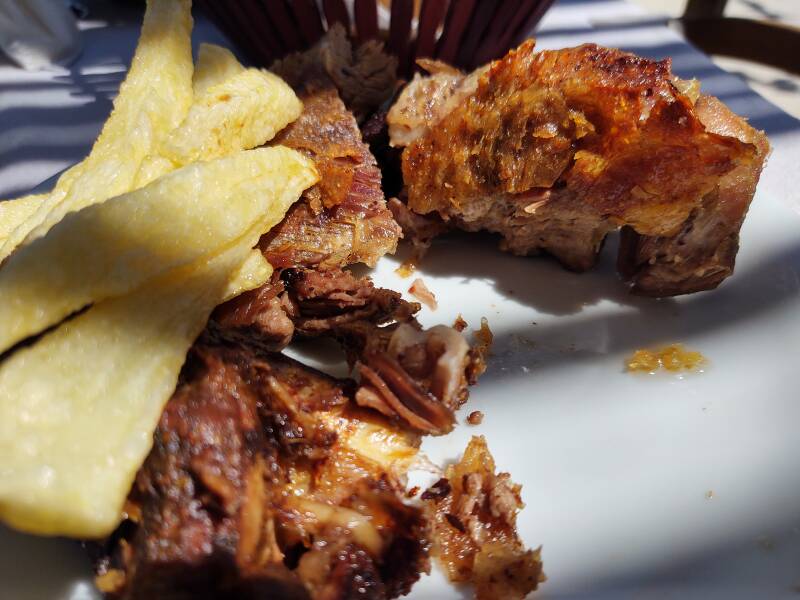

Then, because this is Greece, and especially because this is a mountain village in Crete, and especially because this is Easter Monday, there's a bonus surprise dessert.
Orange slices, yoghurt with cinnamon and honey, and raki.

This is Cretan tsikoudia, called raki in Greece, and not the Turkish rakı which is similar to Greek ouzo.
Cretan raki is made from pomace, the remains of grapes pressed to make wine. It is fermented for about six weeks in a tightly sealed barrel, and then distilled.

As for Kreipe and his captors, they made their way over the Psiloritis or Mount Ida massif, and eventually to the Peristere beach near the village of Rodakino on the south coast. The Andartes returned to the hills, while Leigh Fermor and Moss accompanied General Kreipe and two German POWs and a sick Soviet POW on an SBS motor launch that took them to a waiting submarine.
The submarine took them to Mersa Matruh in Egypt. Kreipe was interrogated there by the British, then sent to a POW camp in Canada, and from there to a special camp in Wales.
From here I continued west to Rethymno.
Where next?
